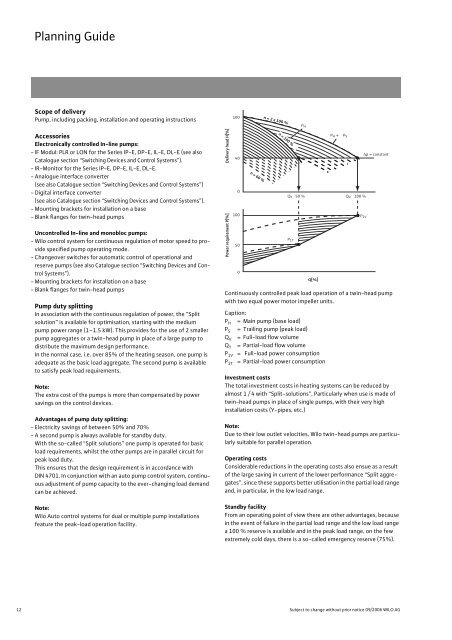Glanded Pumps - THERMO-ECO-ENGINEERING úvod
Glanded Pumps - THERMO-ECO-ENGINEERING úvod
Glanded Pumps - THERMO-ECO-ENGINEERING úvod
You also want an ePaper? Increase the reach of your titles
YUMPU automatically turns print PDFs into web optimized ePapers that Google loves.
Planning Guide<br />
Scope of delivery<br />
Pump, including packing, installation and operating instructions<br />
Accessories<br />
Electronically controlled In-line pumps:<br />
- IF Modul: PLR or LON for the Series IP-E, DP-E, IL-E, DL-E (see also<br />
Catalogue section “Switching Devices and Control Systems”).<br />
- IR-Monitor for the Series IP-E, DP-E, IL-E, DL-E.<br />
- Analogue interface converter<br />
(see also Catalogue section “Switching Devices and Control Systems”)<br />
- Digital interface converter<br />
(see also Catalogue section “Switching Devices and Control Systems”).<br />
- Mounting brackets for installation on a base<br />
- Blank flanges for twin-head pumps<br />
Uncontrolled In-line and monobloc pumps:<br />
- Wilo control system for continuous regulation of motor speed to provide<br />
specified pump operating mode.<br />
- Changeover switches for automatic control of operational and<br />
reserve pumps (see also Catalogue section “Switching Devices and Control<br />
Systems”).<br />
- Mounting brackets for installation on a base<br />
- Blank flanges for twin-head pumps<br />
Pump duty splitting<br />
In association with the continuous regulation of power, the “Split<br />
solution” is available for optimisation, starting with the medium<br />
pump power range (1–1.5 kW). This provides for the use of 2 smaller<br />
pump aggregates or a twin-head pump in place of a large pump to<br />
distribute the maximum design performance.<br />
In the normal case, i.e. over 85% of the heating season, one pump is<br />
adequate as the basic load aggregate. The second pump is available<br />
to satisfy peak load requirements.<br />
Note:<br />
The extra cost of the pumps is more than compensated by power<br />
savings on the control devices.<br />
Advantages of pump duty splitting:<br />
- Electricity savings of between 50% and 70%<br />
- A second pump is always available for standby duty.<br />
With the so-called “Split solutions” one pump is operated for basic<br />
load requirements, whilst the other pumps are in parallel circuit for<br />
peak load duty.<br />
This ensures that the design requirement is in accordance with<br />
DIN 4701. In conjunction with an auto pump control system, continuous<br />
adjustment of pump capacity to the ever-changing load demand<br />
can be achieved.<br />
Note:<br />
Wilo Auto control systems for dual or multiple pump installations<br />
feature the peak-load operation facility.<br />
Continuously controlled peak load operation of a twin-head pump<br />
with two equal power motor impeller units.<br />
Caption:<br />
PH = Main pump (base load)<br />
PS = Trailing pump (peak load)<br />
QV = Full-load flow volume<br />
QT = Partial-load flow volume<br />
P1V = Full-load power consumption<br />
P1T = Partial-load power consumption<br />
Investment costs<br />
The total investment costs in heating systems can be reduced by<br />
almost 1 / 4 with “Split-solutions”. Particularly when use is made of<br />
twin-head pumps in place of single pumps, with their very high<br />
installation costs (Y-pipes, etc.)<br />
Note:<br />
Due to their low outlet velocities, Wilo twin-head pumps are particularly<br />
suitable for parallel operation.<br />
Operating costs<br />
Considerable reductions in the operating costs also ensue as a result<br />
of the large saving in current of the lower performance “Split aggregates”,<br />
since these supports better utilisation in the partial load range<br />
and, in particular, in the low load range.<br />
Standby facility<br />
From an operating point of view there are other advantages, because<br />
in the event of failure in the partial load range and the low load range<br />
a 100 % reserve is available and in the peak load range, on the few<br />
extremely cold days, there is a so-called emergency reserve (75%).<br />
12 Subject to change without prior notice 09/2006 WILO AG<br />
Delivery head H[%]<br />
Power requirement P[%]<br />
100<br />
40<br />
0<br />
100<br />
50<br />
0<br />
n = 60 %<br />
n = 2 x 100 %<br />
n = 100 %<br />
PH<br />
QT 50 % QV 100 %<br />
P1T<br />
Q[%]<br />
PH +<br />
PS<br />
p = constant<br />
P1V


